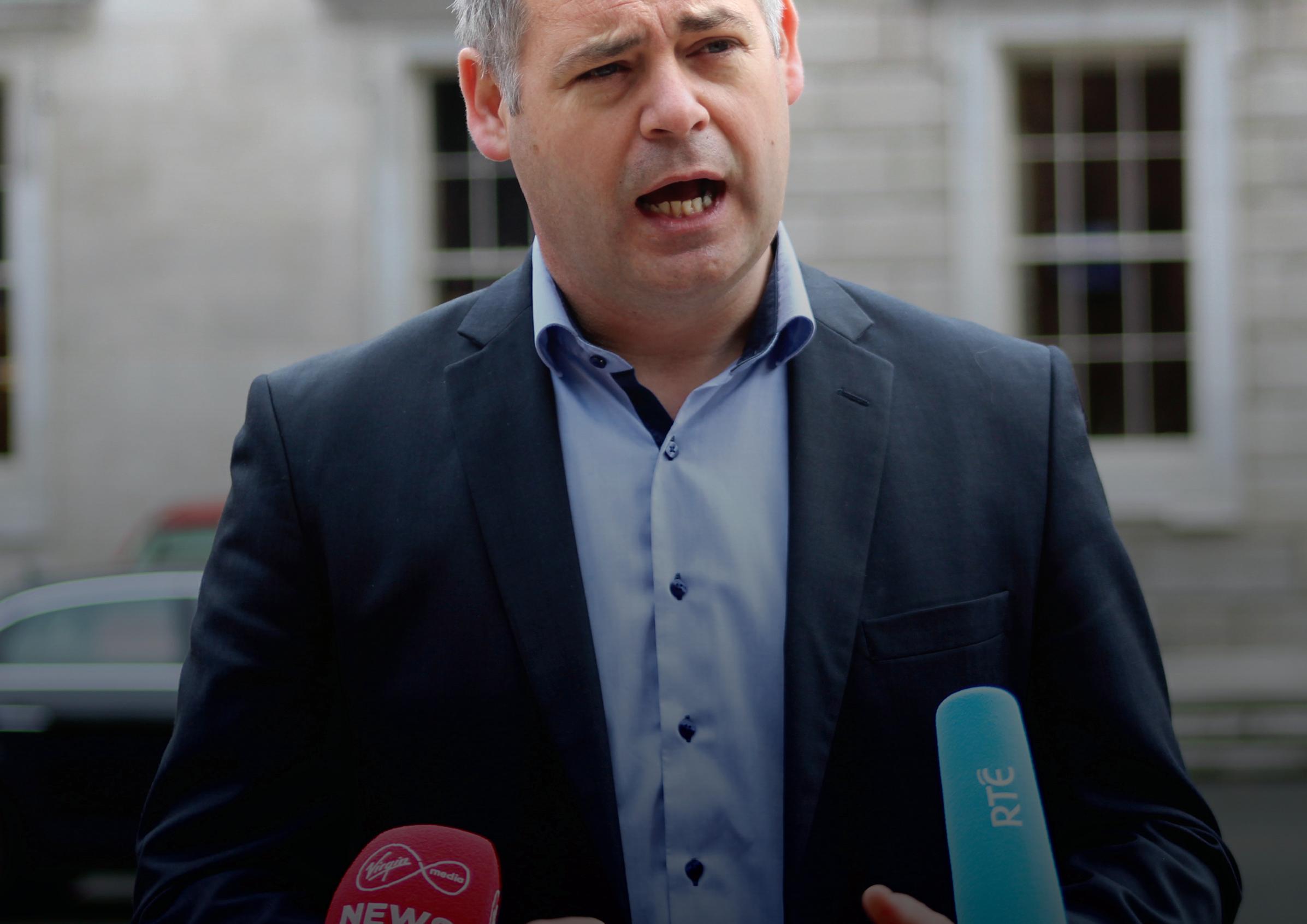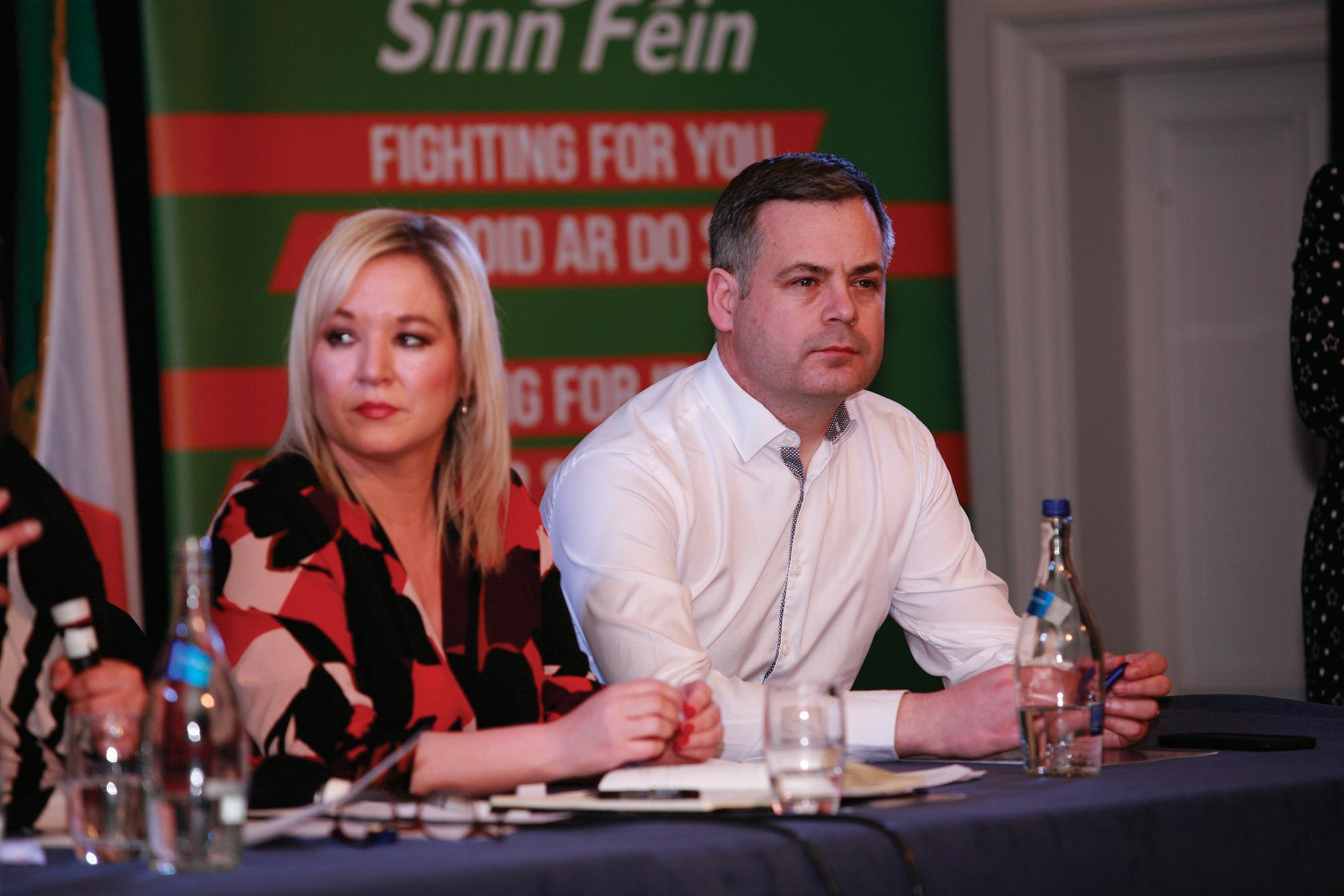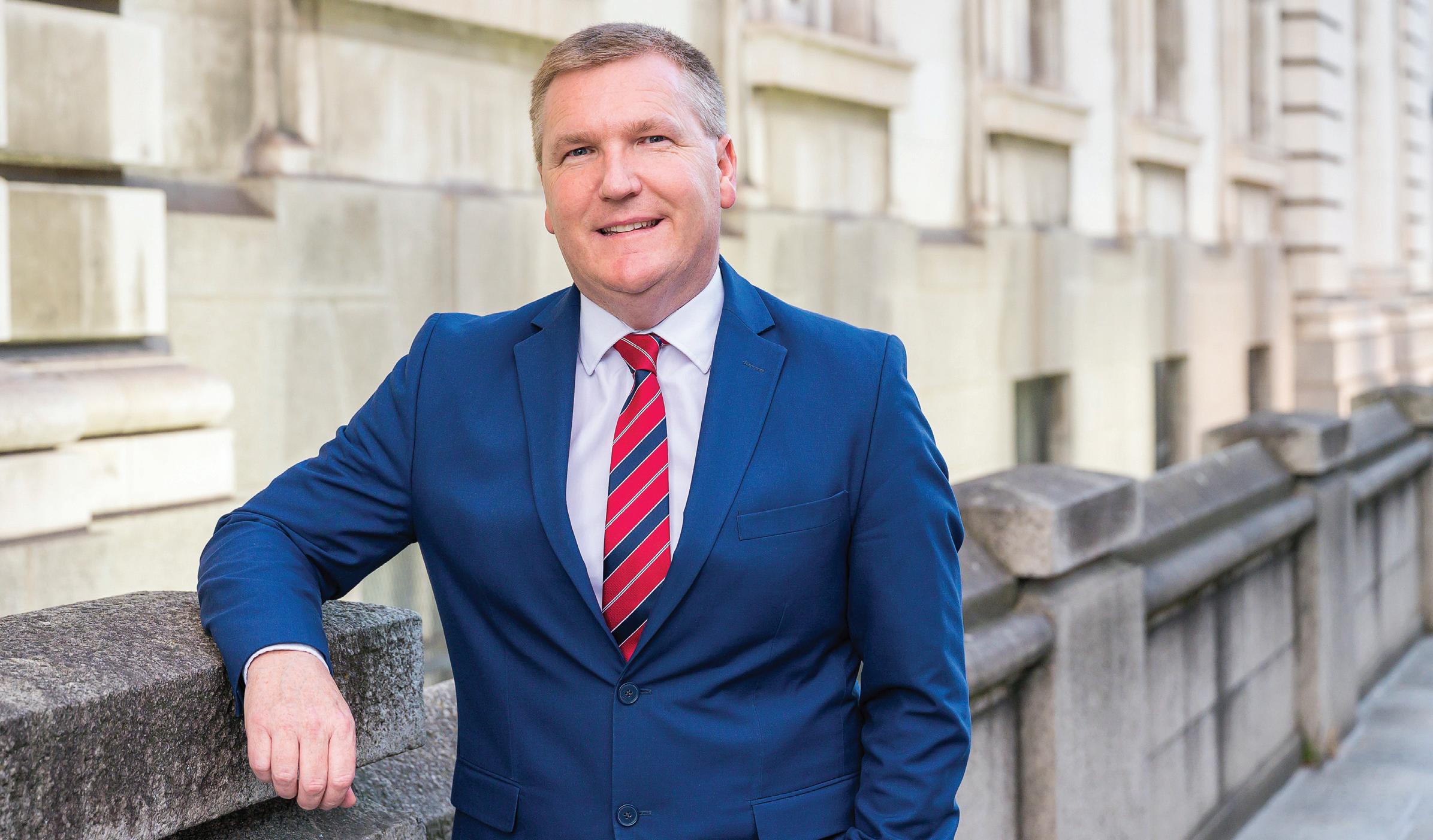
42 minute read
Interview: Sinn Féin finance spokesperson Pearse Doherty TD
PEARSE DOHERTY TD: “We have the team to deliver”

Ciarán Galway sits down with Sinn Féin Spokesperson on Finance and Public Expenditure and Reform, Pearse Doherty TD, to discuss his party’s fiscal policy, the Covid crisis and recovery, and Irish unity.
Having delivered his party’s response to government budgets for 12 consecutive years, Sinn Féin’s TD for Donegal South West Pearse Doherty is intent on becoming the next Minister for Finance. Asserting that “for too long, it is the vested interests which have had the ear of government”, he is determined to “make real change for a lot of people whose voices, in my view, have never been heard in the corridors of power”. For Doherty, it is a matter of placing “ordinary people” above landlords, speculators, and high financiers.
Eschewing the charge of naïveté, he acknowledges that change comes dropping slow, but suggests that the opposite is also true. In the words of Lenin: “There are decades where nothing happens; and there are weeks where decades happen.” “Change can happen fast if the political will and determination is there. That’s why I want to be Finance Minister because I know I can do a lot of good in that role,” Doherty insists.
To illustrate his point, the Sinn Féin Ard Comhairle member refers to erstwhile Fianna Fáil Education Minister Donogh O’Malley’s surprise proposal for free secondary education in September 1966.
While he had consulted neither his department nor his cabinet, he had tacit approval from Taoiseach Seán Lemass and the public greeted the announcement with widespread support, effectively precluding O’Malley’s cabinet colleagues from opposing the policy.
Tax policy
While Sinn Féin is frequently characterised as a “high-tax, antibusiness party” by its political opponents, the finance spokesperson argues that it is in fact a “fair tax party”. “The reality is we are pro-business; we want to see more support for small and medium enterprises. However, we do believe that there needs to be increases
on employers’ PSRI at higher earner level,” he retorts.
Doherty highlights advocacy for the inclusion of increased research and development supports in Finance Bill 2020 as one indicator of his party’s support for SMEs. “I think we need to go a lot further because when you pare back what is happening in Ireland, particularly with SMEs, we are not as productive or as profitable as we should be in relation to our European competitors. There is a lot of focus on FDI which creates high value jobs and a good return to the taxpayer, but we believe that focus cannot come to the detriment of SMEs,” he argues.
On its proposed increase of employers’ PRSI on salaries over €100,000 to a rate of 15.75 per cent, Sinn Féin’s finance spokesperson references the substantial supports provided to businesses, employers and employees throughout the pandemic. The reality, he indicates, is that “we cannot have those type of safety nets if we’re not willing to contribute to them” and as such he believes that the proposed increase has been vindicated.
Interestingly, for a party of the left, Sinn Féin’s 2020 manifesto committed to “retaining the 12.5 per cent corporation “We have seen it in terms of the onshoring of intangible assets, where all the costs can be written off against future profits,” he details. This loophole was identified by Séamus Coffey, former chair of the Irish Fiscal Advisory Council, in the Review of Ireland’s Corporation Tax Code commissioned by the Department of Finance.
“The biggest tax change that Sinn Féin advocates and the one which would bring in the most amount of money –close to €750 million each year – is a tax recommendation put forward by [Séamus Coffey]. That was his proposal. Therefore, the type of proposals we are putting forward are far from reckless,” Doherty asserts.
tax rate that has been key in attracting many multinational corporations to locate in Ireland”.
“The 12.5 per cent rate has served us well,” Doherty says, adding: “I think we have moved on and the discussion is not about the tax rate anymore. The discussion is about what is happening around the edges of that and the way that profits can be shifted or be written down to sub-degrees or to zero by very aggressive tax planning.”
While not advocating for a change to the corporate tax rate, Sinn Féin does propose that associated loopholes are “damaging Ireland’s reputation at home and abroad” and should be closed. parameters set down by the Department of Finance and within the fiscal rules, despite the fact that we believe they are too restrictive”, Doherty argues that it offers a “clear choice”.
“We believe that we should be bringing in a third rate of income tax. This is something that the IMF called for just a fortnight ago; that countries should look into taxing higher income earners. That’s a tax that would continue to generate income, yearon-year.
“That’s not the type of approach that Fianna Fáil and Fine Gael want to take. They would rather hit us with carbon taxes, consumption taxes and allow loopholes to exist which allow for companies to write down their taxable profits to close to zero.”
Sustainability
Regardless, a recurring criticism of Sinn Féin’s tax policy, and one strongly refuted by Doherty, is its potential unsustainability beyond year one. “Those that make that charge are our political opponents who are unwilling to, for example, tax the banks. The banks aren’t going to be paying corporation tax, not just for one year, but for 20 years,” he replies.
Emphasising Sinn Féin’s annual costed alternative budget, published “within the
Global tax challenges
Reiterating his belief that corporate tax loopholes are damaging Ireland’s reputation in Europe and beyond, Doherty suggests that these “allow the impression to exist that Ireland is a type of rogue entity in relation to taxation”. Conversely, the Sinn Féin frontbencher asserts that as a small and open island economy, Ireland “should have the right and has a legitimate right to use taxation to give us a competitive advantage”.
However, he qualifies this by asserting that this competitive advantage “cannot be on the back of developing nations or as part of a race to the bottom”. “There has to be flexibility in terms of steering taxation policy to allow Ireland to compete with nations that are far bigger and may have competitive advantages that we do not have. Ireland has a lot more than taxation to offer and that is why it has been so successful up until this point,” he observes.
In the US, the Biden administration’s global tax plans could have significant repercussions for Ireland. However, as yet, these plans have yet to navigate the US Congress or Senate. While Doherty does not believe that Ireland will
necessarily lose economic advantage in terms of FDI, he is cognisant of the wider macroeconomics “beyond our control”.

“The big challenge for Ireland is not from Biden’s proposed increase in the rate [of corporate tax], it is more in terms of what his administration is doing in relation to the Global Intangible Low-Taxed Income [GILTI] which he is increasing from 10.5 per cent to 21 per cent. That will apply to profits which are moved from a company that is based in Ireland and is repatriating profits to the US; they will be hit by double the tax rate after the Irish taxes are made.
“The impact here is not that Ireland will receive less tax, it is that the US will receive more. The question is whether that will dissuade future companies from locating in Ireland as their centre, or whether it will dissuade companies that are here from making a new investment,” he explains.

Ireland has already factored a €2 billion reduction in corporation tax receipts into its fiscal parameters as a result of potential changes produced by the OECD Base Erosion and Profit Shifting (BEPS) negotiations and the Biden proposals. However, Doherty also emphasises that Ireland has much more to offer than an advantageous tax rate. Factors contributing to Ireland’s economic competitiveness include access to Europe; a highly educated and English-speaking workforce; and relative government stability.
Simultaneously, the Sinn Féin TD identifies two conspicuous challenges. The first is a requirement for “proper and substantial” investment in education and the second relates to infrastructure and cost of living. “Many companies will tell you that one of the biggest challenges they face in terms of locating in Dublin is that they cannot find accommodation for their employees. That’s why major companies are buying up apartment blocks and buying houses from plans. Much of the development that is happening now in our capital and surrounding areas is not being sold on the open market. That is a problem. Reducing the cost of housing through the type of capital investment programme that we are proposing supports our competitiveness and retains that into the future in terms of FDI,” he says.
Credit: Sinn Féin
Covid crisis
While recognising the opportunity of the Covid crisis as a prospective economic gamechanger, Doherty is acerbic in his criticism of government deputies applauding frontline workers in the Dáil little over one year after facing down the striking nurses and midwives.
“It’s very easy to say the right thing at the right time, but a year on, the question is: Have we treated those on the frontline properly? The answer is no. That was exposed last year when the Government opposed paying student nurses working on the frontline,” Doherty maintains.
“I’m sceptical, not that change is going to come, but rather that this government will deliver that change. I genuinely believe that change is coming and that Sinn Féin will be at the heart of that change. This is what the Government really does not want, because its trick is to always pretend that change cannot happen. That was blown apart in the last election; people saw that it does not have to be this way, that Sinn Féin, along with others, can offer real change. That genie is not going back into the bottle
and that is why we have seen our support continue to grow.”

Fair recovery
Reflecting on the social and economic recovery, Doherty re-emphasises his party’s assertion that the any recovery must be rooted in fairness. “I take a lot of hope out of this [crisis]. When government is forced to move, it can move,” he says, referencing the legislature’s consensus on the public health response at the outset of the pandemic.
Elaborating on the principles informing Sinn Féin’s vision for the recovery, the finance spokesperson contends: “The principle is that the State must be there to support you when you are in need. The principle is that certain services need to be public services as a right, not because of how deep your pockets are or who you know. Childcare should be a right, like education. Healthcare should be free at the point of delivery. There should be a right to a home. That’s the type of change that we would bring.”

Irish unity
Sinn Féin’s primary policy objective remains the pursuit of Irish reunification. A persistent theme of the Irish unity debate is cost. In November 2020, the party published Economic Benefits of a United Ireland. The discussion document makes two assertions: firstly, that partition is unaffordable; and secondly, that Irish unity will deliver economic benefits to island of Ireland as a whole.
“Ireland cannot afford partition,” Doherty states, adding: “What our document shows very clearly is that partition has negatively impacted both sides of the border, but particularly the North. In the North, as a result of having no fiscal powers, or very few fiscal powers, decisions are being made in Westminster which really only serve the City of London and the south-east of England and do not serve the regions of Britain and definitely do not serve the North.”
Doherty’s document also emphasises the relative economic neglect which prevails in the border counties. “There is reason why Donegal, which I represent, has the highest levels of poverty, unemployment and medical card usage in the State, alongside the lowest levels of disposable income in the State. Economically, we know Donegal has been forgotten, but partition has had a major impact in cutting off the natural hinterland of the county along with its natural trading partners in Derry, Tyrone and Fermanagh.
“Can we afford partition? No, we cannot. Can we afford Irish unity? Of course, we can. How can I say that? I rely on a peer reviewed international report which modelled Irish unity in a post Brexit scenario and indicated that in the first eight years post-unity, the benefits to the economy would be €23.5 billion, north and south.”
Addressing the challenges in terms of planning for Irish unity, Doherty advocates for the creation of an all-party committee on Irish unity; a civic forum where all communities on the island of Ireland can discuss what a new Ireland would look like; and an Irish Government green paper on Irish unity.
“In the absence of doing that, the Irish Government could be walking into a Brexit scenario. A referendum on Irish unity is part of the Good Friday Agreement. It is outside the control of the Irish Government when this takes place. Given that people recognise that a referendum will take place within the next number of years, whether in five or 10 years – we would like to see it in five –the failure to plan is a very serious failure of leadership by this government.
“Change can happen. I believe that it can, and I know that we have the team to deliver it,” he concludes.
Credit: Sinn Féin
“A referendum on Irish unity is part of the Good Friday Agreement. It is outside the control of the Irish Government when this takes place. Given that people recognise that a referendum will take place within the next number of years… the failure to plan is a very serious failure of leadership by this government.”

Economic recovery: Investing in infrastructure

Contextualising the review of the National Development Plan (NDP), Minister for Public Expenditure and Reform, Michael McGrath TD discusses how an ambitious public capital programme can play a critical role in the recovery of the Irish economy.
Setting out the context for the delivery of a renewed NDP, Minister McGrath acknowledges the critical role of stakeholders in the delivery of infrastructure throughout the pandemic and the importance of the agility shown not only maintaining the economy but providing a basis for future growth.
The Government’s “determination to deliver infrastructure and ensure the country develops in a co-ordinated and well-planned manner” is driven not only by the acknowledgement that Covid-19 will bring about many changes to how the public interacts with infrastructure but also the projection under Project Ireland 2040 of a population increase of some one million people over the next two decades.
Adopted in 2018, the existing NDP outlined a 10-year capital investment programme of around €116 billion aimed at upgrading the country’s infrastructure, enhancing economic capacity and promoting balanced regional development. So far, the plan has progressed a number of key infrastructure projects and the current Government has continued this momentum, including, most recently, through Urban Regeneration Development Fund allocations of around €1.3 billion across different regions of the country from the Minister for Housing Darragh O’Brien TD.
A review of the current NDP was scheduled for 2022 but in November 2020, the Government opted to launch of Review to Renew. Explaining the decision, the Minister identifies an opportunity to “reassess the country’s priorities”. “The review provides an opportunity to reassess our investment plans as a country, to update our project costings and to highlight any new issues that may need to be taken into account considering the priorities in the Programme for Government [PfG] and of course, the ongoing impact of Covid-19,” he states.
Another crucial factor in the decision, which McGrath highlights, is the opportunity to invest in public infrastructure based on access to “funding at historic low rates of interest”, which he says must be availed of in a “considered and careful” manner. Asserting that an ambitious public capital programme can play a crucial role in the recovery of the economy, he contrasts the current economic outlook with that of a decade ago, when the global financial crisis meant that funding was not available and Ireland experienced a peak-
to-trough cut in the public capital programme of some 60 per cent.
By comparison, the €10.8 billion capital budget for 2021, around 5 per cent of GNI*, is not only a record high for Ireland but one of the largest proportional allocations in the European Union.
The Minister outlines a number of key challenges the two-phase review will seek to address, including identifying the appropriate level of public capital investment for the next decade, resetting policy priorities in line with the PfG and closer alignment between the NDP and the National Planning Framework spatial strategy. A further major challenge he raises is around governance of the public capital programme, which he believes can be more efficient.
In April 2021, the Minister published the Phase 1 report on the NDP review, which he describes as an evidence base for Phase 2. The Phase 1 report involves analysis from the National Investment Office and DPER looking at appropriate spending levels and also examines the delivery challenges, with the Minister cognisant that further constraints exist outside finance, such as bottlenecks in the planning system, and that these must be addressed for infrastructure development over the next decade.
The Phase 1 report also deals with sectoral trends in demands across those key areas of climate change, education, and transport, for example. “Critically, it also looks at non-infrastructure investment,” explains the Minister, adding: “Because research and development is increasingly going to be an important part of the NDP, as is digitalisation, enterprise development and equipping people with the skills to match the requirements of a rapidly evolving economy. The NDP is not just about building roads, bridges and houses and our definition and understanding of infrastructure is constantly evolving.”
As well as further exploration of the role of PPPs, McGrath states that Phase 1 will look at the area of assurance, where he has identified the need for essential reform. Several decisions have already been taken in this regard, as he seeks to incorporate greater external involvement and oversight to the public capital programme.
“One of the learnings I have from being in opposition and in observing the management of projects in my time here in the Department is that resources and time spent at the pre-tender stage are generally well spent. If you can pre-empt problems before they arise, it enables projects to go through the delivery phase in a much smoother manner,” he explains.
McGrath has announced his intention to put in place a framework of external experts in major infrastructure delivery, to advise government departments, at the two key “decision gates” of the business case stage and pre-tender stage. Reviews by the experts, he says, will focus on the robustness of planned delivery, the accuracy of cost forecasts, and give consideration of risk and procurement. The Minister is establishing a major projects advisory group to assist his department in managing the external expert framework and assimilating the forthcoming outcomes from their reviews.
Furthermore, the Minister has announced the expansion of the Project Ireland 2040 delivery board to include five external members from the private sector or those who previously worked in public sector infrastructure delivery, who he believes will add rigour and experience.
Phase 2 of the review is scheduled for summer 2021, with the objective of publishing a new 10-year NDP with rolling five-year capital ceilings for departments, which the Minister says will “offer a line of sight and certainty” about the funding they will have over the next five years.
Looking to the future, McGrath projects a swift economic recovery. While under no illusion that that past year has resulted in considerable economic damage, he points to ESRI predictions of 4.5 per cent economic growth in 2022 and 5 per cent in 2023 as a source of optimism, which in tandem with the Government’s new National Economic Recovery Plan presents an opportunity for economic growth.
However, he is also aware of the hangover challenges presented by the pandemic. For example, the Department has identified significant capital underspend across government departments both in 2020 and this year, largely due to the Covid-19 restrictions on construction. Only 10 per cent of capital budget can be carried forward by a department for the following year by law and, in response, the Minister has introduced new reporting requirements for the main capital spending departments to report quarterly to Cabinet on their capital spending to date and their projections for the remainder of the year.
“This will enable the Government as a collective to take decisions to ensure we are making maximum use of the capital budget that is available, even if that means reallocation from one area to another because we recognise the important role of capital investment in recovery. We need to always be looking at ways to improve the productive capacity of the economy and the public capital programme is a huge lever in that regard,” he concludes.

1 2 3


4 5 6
Connecting Ireland and the future of work
Vodafone Ireland hosted a virtual round table discussion with experts from across the public and private sectors, applying their experience and insight to explore the opportunity presented by the Covid-19 pandemic to implement new models of work for the future.
What are the key drivers of change in the future of work and how can we reimagine the way in which we work? What role will connectivity play?
Shelah McMahon There are a range of drivers for the future of work such as technological advancement, increased digitalisation, and advanced workplace communication tools but the most seismic driver has been the pandemic. There has never been a timelier opportunity for us as a nation to review how we work and what we want the future of work to look like. Policy, culture, and tools are the key elements which will help us formulate the future of work and they are fundamental to the needs of the country to recover both socially and economically from the pandemic.
Round table discussion hosted by

Deirdre Frost Technology and broadband are drivers of change, but they are also the enabling infrastructure. The pandemic has served as a driver of change in terms of allowing people to experiment with what remote working might be like, albeit a forced experiment. Previous patterns have shown us that in a tight labour market, employees have more bargaining power and can therefore drive change. A further driver is the low carbon agenda. I think the benefits of remote working, in terms of reduced emissions, should be quantified to a greater extent and this should help inform the debate on both a micro and a macro level. Having analysed remote working for a long period of time, I’m interested to see what elements will gain traction and be sustained beyond the pandemic. Organisational culture and government policy will be critical to this.
Tom Gilligan The key drivers Mayo County Council has identified are technology, infrastructure, and people. Putting people at the centre of everything we do is a critical feature for local government, and we recognise a significant shift in the way we do business, which needs to be supported by policy, technology, and investment. We also recognise that we have a large cohort of staff whose roles do not easily lend themselves to remote working. To this end, there is an important leadership role in managing and engaging staff. The need to connect and collaborate will be even greater in the future and digital technology will be a key enabler.
Tracy Keogh Technology, policy, and culture are the drivers we talk about when transitioning organisations, but we have also identified two additional layers which expand upon these. The first is the hard infrastructure in the form of broadband and hubs but the second is the importance of layering thriving eco-systems on top. We have a tiny window to maximise the opportunities of remote working presented by Covid. If you look at New Zealand, which has now exited lockdown, there has been a massive return to in-office working and so we must act swiftly if we are to capitalise on Ireland’s window.
Ruth Morrissy Undoubtedly, Covid-19 has changed the world of work forever through the acceleration of existing trends such as digitalisation and technology adoption.
One of the major drivers of remote working has been and will be employee demand. Generally, what we have experienced is not remote working to its truest extent; it has been emergency working from home. Despite this, in the Department’s interactions with the public, we are still observing strong interest in remote working continuing to some degree post-pandemic. Employers who embrace remote or flexible working practices are going to see benefits such as access to larger talent pools and improved staff morale. Underpinning policy, particularly in relation to connectivity, is also very important in this regard and that is why a major component of the Remote Work Strategy is focused on having the right national infrastructure in place.
Stjohn O’Connor From a Civil Service perspective, the ability to attract and retain talent is a major driver. We are approaching a point in the Civil Service whereby a large portion of our senior management will be retiring within a short period of time. We need to adjust if we are going to continue to attract talent to work in the Civil Service; broaden the offering; and move away from the expectation of needing to be located close to Dublin.
How can a distributed model of working help to rebalance the economy and what are the benefits?

Tom Gilligan The emerging opportunity and shift of mindset ushered in by Covid indicates that work can be done elsewhere across the country. Campaigns have been launched to bring people back to the west of Ireland. That will enhance the economy on the west coast, particularly in respect of our local towns and villages. It will also breathe new life into our communities and regenerate areas which have been in decline. It’s a great opportunity for people to reduce commuting times, to inject more flexibility into their day and to achieve a better quality of life. This is all conducive to Project Ireland 2040 which envisions a progressive population distribution strategy and the creation of much more balanced national economy.
Deirdre Frost Rural and regional development, as well as the ancillary spend that is associated with people living and working remotely or indeed working from a hub in rural areas, has to some extent been overlooked by concerns about Dublin city centre or other large urban centres. 4

Roundtable Participants
1. Deirdre Frost
Deirdre Frost is a Policy Analyst and Project Manager with the Western Development Commission. She has analysed and published on a range of policy issues relating to regional and rural development including the National Planning Framework and the National Development Plan. Deirdre is also Project Manager of ‘Digiwest’, a project delivering four rural working digital hubs in the western region. Since January 2020, she has led on a collaborative project with NUI Galway on the analysis and promotion of remote working which has undertaken several national surveys on remote working during Covid-19.
2. Tom Gilligan
Tom is a Director of Services and Head of Finance at Mayo County Council. Before joining Mayo County Council, Tom was the Head of Finance with the newly created Limerick City and County Council, the biggest change management programme in local government history. Prior to joining the public sector, Tom had roles in construction, retail, manufacturing, and the pharmaceutical sector. Tom is the holder of an MBA in Local Government and is the instigator and founder of VacantHomes.ie, an initiative of Mayo County Council on behalf of the Local Government Sector. Tom is also an author and recently published his first book Irish Drummers Volume One.
3. Tracy Keogh
Tracy Keogh is a co-founder of Grow Remote and a recognised international leader in the world of remote. Having over 10 years of experience in technology start-ups, Tracy spent the last few years building the largest local community of remote workers in the world. Working to change how employment spreads, she has spearheaded the delivery of training courses in remote to over 35 large enterprises, and 200 individuals.
4. Shelah McMahon
Shelah McMahon is the Head of Public Sector Sales at Vodafone Ireland. Shelah manages the central government portfolio and previously led public sector service management for Vodafone Ireland. Shelah has 25 years of experience across financial services and telecommunications with extensive experience of leading large teams and strategic change programmes. Shelah is passionate about connectivity and pioneering a gigabit society where public and private sector collaborate to democratise connectivity, which will deliver benefits to all citizens living and working in the island of Ireland.
5. Ruth Morrissy
Ruth Morrissy is an Assistant Principal Officer in the Department of Enterprise, Trade and Employment. Working in the Labour Market and Skills Unit, Ruth has led on several projects on remote work, such as the 2019 Remote Work in Ireland report, the creation of the Department’s Guidance for Working Remotely website, and the Department’s public consultation on the topic. Last year, she led the development of Making Remote Work, Ireland’s first Remote Work Strategy which was published in January 2021.
6. Stjohn O’Connor
Stjohn O’Connor is Principal Officer in charge of Rural Development and Innovation in the Department of Rural and Community Development. Stjohn has worked in a variety of departments and is currently responsible for building a national network of remote working hubs, delivering the Broadband Connection Points initiative of the National Broadband Plan, and working with local authorities to innovate with digital technologies. Stjohn holds a doctorate in governance from Queen’s University Belfast.

The debate should not be reduced to an ‘either or’ discourse. In real terms, the proportion of people moving has a benefit for rural town centres that far outweighs any detriment to larger urban centres. At the same time, one key benefit to employers is an expanded labour supply. Whether they are urban or rurally based, they will have improved access to skills from a broader geographic area, which will be advantageous, especially in periods of high economic growth and tight labour markets.
Ruth Morrissy
Increasing participation in the labour market is a huge benefit, not only in terms of traversing geographical boundaries and reducing commuting times, but for the cohorts of people who typically have lower economic participation rates. These cohorts include people with disabilities and people with caring responsibilities who can benefit greatly from the elimination of the commute to work. It also helps attract older workers as they move towards retirement. The flexibility of remote working enables this cohort to remain in the labour market for longer, benefiting society as a whole. What is really striking about the benefits is how many of them are interlinked. For instance, if we can reduce commuting times, we can simultaneously reduce carbon emissions in the transport sector while improving the work-life balance of workers. The possibilities are huge.
Tracy Keogh
There is a gap between the rhetoric and the implementation of remote working policy. Without case studies and toolkits which support organisations to make the transition, we will be stuck in a loop of achieving consensus on the obvious benefits of remote working followed by little tangible action. When we talk about the benefits to communities, often the discussion sways towards repopulation and attracting people from east to west. Kate Lister, President of Global Workplace Analytics talks about remote working being an option for the top 7 per cent of employees. However, this does not produce positive outcomes for our rural communities. Instead, people on higher salaries move in and reduce affordability in these communities. There is much untapped potential in moving away from the top 7 per cent and providing career opportunities to the existing talent in rural and regional communities.
Shelah McMahon
The distributed model of working also incorporates government policies, employer policies and employee policies. Likewise, culture is intrinsic to making this work. As the infrastructure becomes available, whether that be the collaborative tools to work from home or the creation of digital hubs, unless there are appropriate policies both from the organisations and the State, alongside an authentic culture which trusts and empowers people to work from locations other than fixed offices belonging to the organisation, it will not yield sustainable benefits. The opportunity to work remotely cannot merely extend to a privileged cohort that does not actually contribute to the social fabric of rural Ireland. Similarly, the distributed model of work will only achieve sustainable success if there is distributed equality of access to the digital skills which can capitalise on that opportunity.
Stjohn O’Connor
If you consider the research literature on building resilience in rural communities, one of the consistent themes is moving away from the traditional primary and secondary industries to establish a broader economic base. What we’re talking about here is an opportunity to achieve that, for the first time. It involves attracting different types of industry and jobs into communities to create a much more sustainable pathway to economic growth. From a community development perspective, there are far more people currently able to be involved in their communities because of the shift to remote working. That’s another redistributive effect for rural Ireland. Much of our society is built on volunteerism and people investing their spare time into local initiatives. When people are locked into a two-hour commute, it does not leave a lot of spare time for voluntary work.

Deirdre Frost, Policy Analyst and Project Manager, Western Development Commission
What are the most significant obstacles to implementing new models of working?
Tracy Keogh We developed a maturity model for organisations transitioning away from coping remotely to thriving remotely, which we split in to three groups: CEO leadership; people managers; and the rest of the organisation’s talent. In one organisation we worked with, we found that 90 per cent of staff said that they wanted to work remotely but 77 per cent of people managers said that they wanted people back in the office. What that tells us is that people managers need more support but also that this must be CEO-led because leadership is the missing component. A general understanding of the potential benefits is present but there is insufficient research into what is being lost in terms of collaboration and culture. The starting point must be case studies because fully remote has been tested and in-office has been tested but we have yet to fully evaluate a hybrid, remote first model at scale.

Stjohn O’Connor That community penetration is exactly why we are developing the national hub network because we see the value of leadership and we have been approached by companies who recognise the value the network will bring. The Western Development Commission will undertake a marketing campaign around the network, but we also recognise that it needs to be a bottom-up campaign. If we have 400 hubs on the network, they need to be actively promoting the availability of jobs and of a mechanism to attract those jobs into their communities. In addition, we would like to see a community dividend emerging from hubs in the network that would see them providing additional services to the community. Deirdre Frost To me the major obstacle is inertia and missing the opportunity to grow the remote workforce for the future, because at present we are working remotely in an enforced regime. Taking the point about New Zealand not seizing the remote working opportunity, Ireland could be the same if we do not act. I am led to believe that there is already a slow and steady return to the workplace. If that is because of inertia, then we need to move to counteract that and consolidate remote work practices. To do so, we need a better understanding. In the surveys conducted in partnership with the Western Development Commission and NUI Galway we see that for many people, their understanding of remote working is grounded in the emergency working from home model we have all experienced over the past year. I think we can take lessons from those countries who are more advanced in their response to the pandemic.
Stjohn O’Connor One of the most interesting findings to have emerged from our surveys within the Civil Service was a widespread lack of knowledge of the third option; working in another facility such as a community hub. Part of our role is to disseminate that information but also to show leadership. We are awaiting approval on a proposal that would see existing OPW facilities around the country be transformed into remote working hubs for civil servants at very little cost. It is something I am keen to introduce because I think it would serve as a demonstration of how the public sector is embracing remote working opportunities.
Tom Gilligan I think there are three identifiable obstacles. The first is culture and how receptive an organisation is to change. The second are the resources available to an organisation, including finance, skillsets, and infrastructure. The final obstacle is employee change fatigue. Employee change fatigue was an obstacle pre-pandemic, when it was recognised that constant introduction of new ways of working negatively impacted on staff morale and productivity. We have been through a substantial change in the last year and employee capacity for new ways of working needs to be a big factor of how we plan for the future.
Shelah McMahon
There is a critical role for leaders, whether they be private or public sector, not just to be the drivers of change but also to identify the various employee needs at different stages of their careers. Those entering the labour market will have a different requirement to those nearing retirement and that will be different again for those with caring responsibilities. Balance is key and crucial to finding that balance to deliver a future, successful way of working is asking the people who are going to deliver that model what they need and then delivering that through policy and culture changes.
Ruth Morrissy Mindset and culture are significant challenges and I think as more people managers receive training, that will help to develop trust, as will the constant improvement of collaboration tools. One of the barriers we heard much about was the ability to switch off and the right to disconnect when remote working. Under the National Remote Work Strategy, the Workplace Relations Commission recently published a code of practice on the right to disconnect which will hopefully provide people with a lot more understanding of how the law will apply in these remote scenarios, helping both employers and employees. 4

Tracy Keogh, Co-founder, Grow Remote
How can new ways of working align productivity and engagement with a healthy work-life balance and what does this mean for rural communities?
Ruth Morrissy In terms of productivity, there is a significant volume of research which provides a mixed picture on whether remote working is more productive or not. One significant piece of research undertaken by Microsoft polled 9,000 managers across 15 countries and found that remote working had been equally productive or improved productivity for the majority of companies. There are significant implications if people can get more work done in the same amount of time. It could help to prevent overworking or working later into the day. Paired with a reduced amount of time spent commuting, this will unlock much more time to be spent locally, increasing engagement within the community.
Deirdre Frost The research we conducted was very consistent. The issue with productivity is the extent to which people are using extra time to do the same job, versus the time they have left over to invest in their local community. The Western Development Commission/NUI Galway surveys from 2020 indicate that people had much more free time because they were not commuting and some of this was spent working. This may be due to an initial learning curve whereby people were getting to grips with new ways of working or things were taking longer. However, one thing that is very clear is that at least some of that saved commuting time is being used to invest in individual wellbeing, community wellbeing and family wellbeing. That can only be a good thing.
Tom Gilligan Alongside productivity, it’s about people and place. Our Rural Future, the recent government document that sets out several objectives to transform rural Ireland, encourages vacant properties to be brought back into use as community spaces and technology hubs. That will benefit the local community by enhancing access and therefore choice. Improved productivity is about ensuring that a task is completed in the most efficient manner possible. The new ways of working will help align with that objective. At the same time, in Mayo County Council, we have placed a particular emphasis on people’s mental wellbeing. Amid Covid, an increased number of people are working in isolation, inhibiting the collaboration traditionally associated with an office environment. Early on, at the start of my own career, I was advised to always take time and sit with colleagues from different sectors of my organisation. I learned a lot from that experience. People miss that aspect of work and we must be mindful as employers that we monitor mental wellbeing and ensure regular contact with colleagues as we implement new ways of doing things.
Shelah McMahon This pivot towards new ways of working feels much more significant given the context of the pandemic. There must be a holistic focus on the wellbeing of the community of people who work within any given organisation. The wellbeing of the people availing of the distributed model of working is critical to the success of that model. The wider culture, inclusivity and diversity of an organisation will contribute to this success. One of the most interesting aspects of this conversation is that there appears to be a consensus that the tools and infrastructure are there. We must then layer on the public and private policies from the State and organisations, as well as cultures. These are the pillars for the delivery of the future of work, wherever you work and however you consume your services.
Stjohn O’Connor There needs to be very specific research from within individual sectors as well as on a national basis as to where the dividend of remote working will be felt. Everyone knows that there are pervasive benefits across all sectors of society and the economy, but we have not yet reorientated the research to look specifically at each of those elements. We have spoken to the Western Development Commission about understanding the immediate economic

Ruth Morrissy, Assistant Principal Officer in the Department of Enterprise, Trade and Employment
impact on communities, but we must give broader consideration; to the carbon emission dividend, for example, and involve others such as the Department of Transport. In each of those areas, we need the policy experts to consider ‘what is the dividend, and can we put a price on it?’ Then we will start to see the full picture of remote working and articulating the vision will become a lot easier.
What lessons have been learned over the last year with enforced distributed working across the country, especially for those delivering state services to citizens and how citizens consume them?

Deirdre Frost Amid this new enforced layer of digitalisation, we must extend the remote working dividend into wider society. I make that point because the Western Region and rural regions generally have a higher population in the economically inactive cohort. It strikes me that while many of the benefits of remote working may not have been properly quantified, it is very clear that they have been felt by the economically active. I am hopeful that these benefits will be felt by wider society, including those who are not in the labour force. In the context of the digital divide, many older citizens have improved their digital literacy. While this has occurred across vast swathes of the population, including through remote access to health services and education services, I am cognisant that the lessons and skills I and others have learned through remote working might not be universal.
Tracy Keogh Grow Remote has observed that many people now have a personal experience of remote working and that experience informs their associations with the wider concept. If someone had a negative experience during the emergency working from home period, then they are likely to have a negative perception of remote working more broadly. Even when we discuss the remote first concept, some people say, ‘well, I want to be in the office sometimes,’ as opposed to recognising that it is location agnostic. To move past this, we need to broaden the perspective and avoid forcing a particular model upon individuals.
Ruth Morrissy The biggest lesson is that it can be done. Many organisations had a cultural mindset that they could not do it or that their roles weren’t applicable. Obviously, that is true in some very specific sectors. With organisations like the Civil Service, where previously there was not a significant volume of remote work being undertaken, it soon became apparent that many roles could be fulfilled from home with some ease. In terms of improving the delivery of state services, I spoke with my colleagues in the employment permits section to gather an understanding of how they have been transitioning with their workload. In the relatively short period of time of working remotely, these colleagues have replaced all the paper-based elements of their system and are now providing all their services digitally. There are significant benefits for applicants in that scenario as permits are now provided via email, which is faster and more reliable, improving overall customer service.
Stjohn O’Connor The simple point is that it works. We have all adjusted and accelerated changes that were on the agenda for a long time but did not previously have enough momentum behind them to be implemented. We had no option but to make those changes which has resulted in rapid innovation. It has shown that we can change, develop, and try new things. There must be an acceptance of the need to plan for the future, recognising that we can change, and we can succeed. The greatest lesson from a Civil Service perspective is the willingness to innovate and to take risk. A window of opportunity now exists, and we need to seize the moment, driving changes that unlock ubiquitous benefits and avoiding a backwards slide into traditional patterns.
Tom Gilligan One of the key lessons has been around communication. How, when and what we communicate with people is now more critical than ever. The second lesson concerns technology and skillsets. What we have learned is that it is important to adopt the most relevant technology and have the necessary skills to use it effectively. For instance, in Mayo County Council, we have launched a consultation portal around the new county development plan, providing people with the opportunity to submit their observations online. Consequently, this has injected a greater degree of flexibility into the process. Simultaneously, we must be conscious that there are certain cohorts of the workforce, particularly those in construction and manufacturing, which are still required to be on-site and cannot fully embrace the benefits and flexibility of remote working.
Shelah McMahon The single biggest lesson for my team, and Vodafone Ireland more broadly, has been to experiment and learn fast. Amid the pandemic, we needed to be braver, and leadership was required to be more agile. Speed often trumps perfection. This has meant being open to making mistakes and learning from these. We were forced to do that over the last year and given the ongoing public health restrictions, that continues to be the case. Post-Covid, it would be a shame if we missed the opportunity afforded by the crisis to share socio- economic growth across the island of Ireland and instead regressed back to pre-pandemic working practices.










